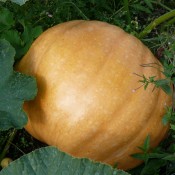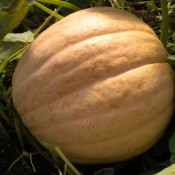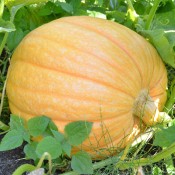Cucurbita maxima.
Dill’s Atlantic Giant is the best variety for growing giant pumpkins…..producing world record size pumpkins. Howard Dill, from Windsor, Nova Scotia, was a giant among giant pumpkin growers. He won four consecutive world championships from 1979 to 1982, a feat unmatched by any other grower. He missed winning his fifth title by a mere 5 pounds. The present day world record for the Dill’s Atlantic Giant is 1,689 lbs grown by a man from Rhode Island. The current (October 2008) California, British Columbia, and Canadian record holder is Jake van Kooten from Port Alberni, B.C. whose Atlantic Giant weighed in at a staggering 1,536.5 lbs (697 Kg). Even if you don’t want to grow a ‘record breaker’, it is excellent for pies, carving Jack O’Lanterns, etc. Fruit colour varies from yellow to orange to pink-orange.
If you want to try your green thumb at growing a giant pumpkin, these are Howard Dill’s recommendations:
- Cool growing climates such as Washington, New Hampshire, Pennsylvania, northern California, and of course, Canada
- Soil pH ranging from 6.5 – 7.0 with plenty of organic matter, such as compost or manure
- Allow plenty of space between plants (the more the better)
- Provide shade cover for vine and pumpkin to reduce stress, if the summer temperatures are above 90°F (32°C)
- Plenty of water (did you know a giant pumpkin can gain 10-20 pounds a day?)
Nutrition: Pumpkin is full of an important antioxidant, beta-carotene. Current research indicates that a diet rich in foods containing beta-carotene may reduce the risk of developing certain types of cancer and protects against heart disease. It is also a good source of zinc, iron, and fiber. One cup of cooked pumpkin is about 49 calories.
| Maturity | 120+ days |
|---|---|
| Height | 30” (76 cm) |
| Spacing | 8 ft (2.44 m) |
| Light | Full Sun |
| Soil | Deep, organic, compost rich and well draining |
| pH Range | 6.5 to 7.0 |
| Watering | Water regularly & evenly to produce large pumpkins. |
| Fertilizing | Balanced fertilizer at time of planting; work in manure/compost |
| Nutrients Required | The initial stage of fertilizing should be based on maximizing phosphorus for root development. Once roots are established then shift to a well balanced fertilizer with more nitrogen. Prior to setting the fruit, switch to a higher potassium formulation for development of the set fruit. |
Back to PUMPKIN



